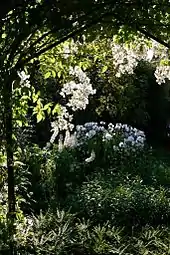Color garden
The term color garden has in popular use two contradictory interpretations. A color garden has a variety of colors in it so that it is more attracting. In the first sense, a color garden is a garden specially planted in order to display a wide variety of colors, often in a particular season (for example a fall color garden). In the second sense, a color garden may more accurately be labeled a single-color garden.

Single color gardens
Such a garden is planted so that it overwhelms the observer with a single color. While this may seem a rather bland approach at first, such gardens were made popular by the work of famous garden designers such as Gertrude Jekyll and Vita Sackville-West. Sackville-West, for example, created what may have been one of the most famous single-color gardens, the White Garden room of the Sissinghurst Castle Garden.
White garden

A white garden is a feature garden composed of plants that produce white flowers and spathes as well as plants with a white or silvery cast to their foliage. The white garden is a variant of the color garden. The most essential feature of the white garden is its unity of colour.
The white garden is an informal gardening style that is similar in design to the English cottage garden. The open and informal design creates associations with romance, peace, and elegance. The white flowers are not usually placed in clusters, but spread throughout the garden's green areas, creating a natural look and feel. The mildly dense placement of white flowers creates a luminescent sight that is especially powerful in the twilight.
The colour white, and white flowers in particular, carry a vast amount of symbolism.
Flowers used in white gardens
- White camellia
- Shasta daisy
- White lilac
- Madonna lily
- White periwinkle
- White rose
See also
References
